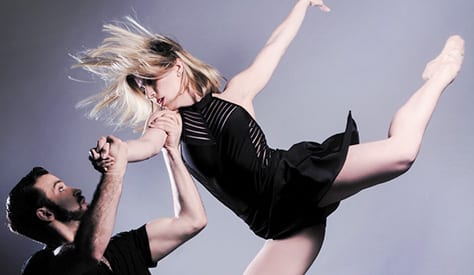Bess Kargman documents the grace of ballet in ‘First Position’

FIRST TIMER | Kargman, above right, leapt into filmmaking from journalism to make her debut documentary.
ARNOLD WAYNE JONES | Life+Style Editor
…………………
FIRST POSITION
Now playing at Landmark’s Magnolia Theatre in the West Village
…………………
If the image that pops in your head when you think of a movie director is of a middle-aged, bearded guy wearing a ball-cap and sneakers, then Bess Kargman is definitely not the first person you’d seek out on the set. In fact, when you realize she’s also a former journalist, you might look for the nicotine stained fingers; you won’t find them.
Instead, you’ll see a petite young woman in an Ann Taylor sheath (size 2, max) staring at you from behind big doe eyes.
Which is exactly the challenge she faced when she decided to make her debut documentary, First Position.
The decision to become a filmmaker wasn’t as difficult — or as compelling — as you might expect.
“I trained as a journalist — I went to Columbia School of Journalism,” Kargman says at a suite in the Hotel Palomar on a recent swing through Dallas. “For me, all storytelling is just storytelling, whatever the format of the medium.”
And the story she wanted to tell was about ballet — specifically, the kids who sacrifice so much for the shot at dancing glory.
“I danced my whole childhood, so when it came to picking talent, that was the easy part,” she says. “I wanted a really diverse group of kids — someone from a Latin background and an African-American to show that not all ballet dancers are white. I wanted siblings. And boys.”
She got everything she needed when she poked her head into the dance competition portrayed in the film.
“I saw the most unbelievably beautiful dancer. I’d never seen such talent before in such a young kid,” she says. The next step was to make the movie.
Having trained on news documentaries, Kargman felt a natural progression to features that served her better than if she set out for a Hollywood career.
“If I had gone to film school, I never would have believed I could do this,” Kargman laughs. “I would be daunted by how many people wanted to do what I did.”
She approached the process methodically. The first step was to find a cinematographer who could light everything from a cramped New York City apartment to the stage of a theater. Just as difficult was finding a seasoned pro who was willing to take orders not only from a young director, and a first-time director, but a female director.
“I rewatched every documentary I’d ever loved. Then I called up the people in the credits. They usually said the same thing — ‘I’m unavailable and you can’t afford me.’ But one added: ‘This guy is equally talented and might be free.’ And that was Nick Higgins. The minute I saw his stuff I knew he was the right one.”
Kargman has been surprised at one thing about the marketing of her film: Until our interview, no other gay media had expressed an interest in her film, a fact she found somewhat puzzling: Not only does ballet traditionally appeal to gay men, but several of the dancers are gay … at least, that’s what Kargman suspects.
“I didn’t ask them directly, because I didn’t want to come up to an 11-year-old and ask about their sexuality, but I would say at least one of my dancers is gay. You can just tell. But they were all minors and I didn’t want them to have to wear a rainbow-colored shirt just to make a point,” she says.
That’s not necessary. When a film is a graceful as the bodies on screen, you just get lost in the beauty. Which was what she wanted to convey all along.
This article appeared in the Dallas Voice print edition May 25, 2012.

